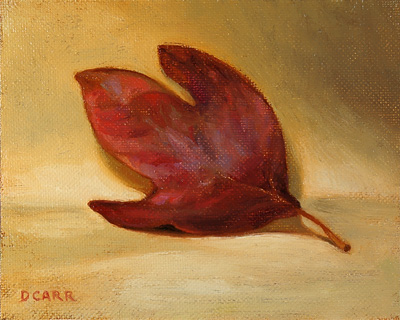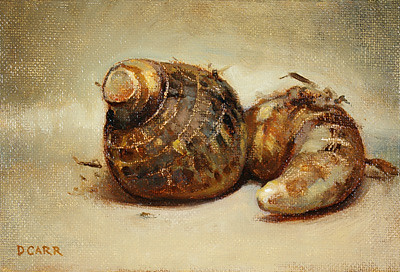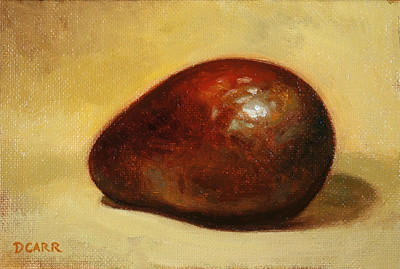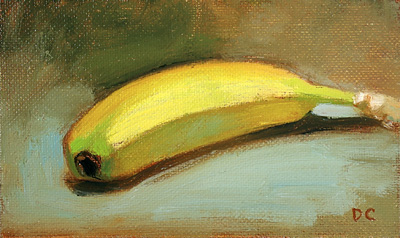
10/12: Banana sketch, oil on canvas panel, 3x5 in.
I attempted here to use a bigger brush than usual and suppress my urge to break up the broad marks. I really like the green in the back - I'm still amazed by that discovery.
When I was laying down the ground on some of these recent panels I took the time to smooth the surface with the edge of my long palette knife, getting the little holes in the canvas filled more. It makes a huge difference, needless to say, in the movement of paint across the surface. This is something I should have been doing all the time, properly at the white priming stage, but I haven't always been oil-priming these panels either. I need to get a proper priming knife (or cake frosting spatula) and a bucket of oil ground, and become a real painter one of these days.
Saturday, October 13, 2007
Banana sketch
Posted by
Dan P. Carr
at
11:37 AM
2
comments
![]()
Tags: daily painting, food, materials, studies
Friday, October 12, 2007
Sassafras leaf
 My daughter loves to examine leaves on the ground. This one I took inside with me because it was in decent shape and the deep red was great. I'd seen this type of leaf a thousand times and not known what tree it comes from, so good thing we have a Trees Fandex Family Field Guide. Big kids would have fun with this book and its die-cut leaf shapes, which make it very easy to match our most common tree species (the annoying thing is that the pages catch on each other).
My daughter loves to examine leaves on the ground. This one I took inside with me because it was in decent shape and the deep red was great. I'd seen this type of leaf a thousand times and not known what tree it comes from, so good thing we have a Trees Fandex Family Field Guide. Big kids would have fun with this book and its die-cut leaf shapes, which make it very easy to match our most common tree species (the annoying thing is that the pages catch on each other).
I wished I could capture all the subtle colors on this leaf, or at least make a translation that conveyed a fraction of the complexity that I saw. But I could go nuts trying to do that, as I felt I might when I went over the same area for the fourth time to get it "right." So, on the other hand, I wish I was able to simplify a leaf (the way I possibly could with a fruit) down to the point that all surface nuances were left totally to the imagination. I guess the idioms I use in translating could be better at times. Here the main challenge was balancing the dusty purple in the center, which I played down, and the seemingly hundreds of hot and cool reds throughout.
Posted by
Dan P. Carr
at
11:37 AM
1 comments
![]()
Tags: books, botanical, daily life, daily painting, miscellanea, nature
Thursday, October 11, 2007
Pomegranate #2
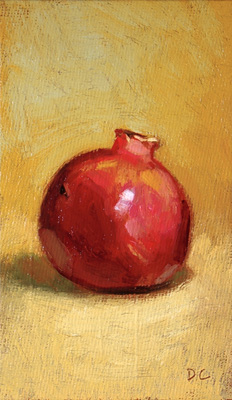
10/10: Pomegranate #2, oil on canvas panel, approx. 5x3 in.
A pleasing little sketch, to me - though longer than a sketch, being about 45 minutes. Maybe for others that is still a sketch, but not for someone with my attention span. If only I could apply some of this looseness to a picture of my face ... why is that so hard?
Posted by
Dan P. Carr
at
12:35 PM
0
comments
![]()
Tags: daily painting, food
Wednesday, October 10, 2007
Pomegranate **VIDEO**
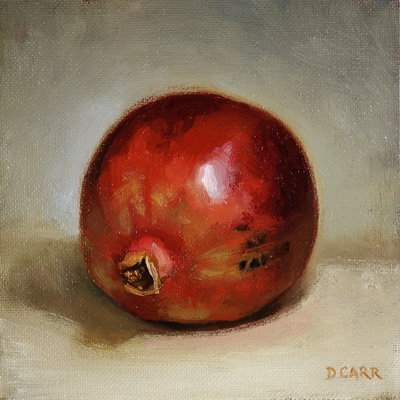
10/9: Pomegranate, oil on canvas panel, 5x5 in.
Maybe because I was able to keep it fairly soft and loose, when seen from across the room this is more convincing than most of my other pieces. It was about 70 minutes.
Posted by
Dan P. Carr
at
12:23 PM
0
comments
![]()
Tags: daily painting, food, videos
Tuesday, October 9, 2007
Red skin potato #2

10/8: Red skin potato #2, oil on canvas panel, approx. 4x6 in. SOLD
I find these potatoes can be real tricky to do when the skin is in half-shadow, when its translucency shows. It involved (for me) a lot of trial and error and back and forth, especially here as the potato is cut and more light filters through the skin from the inside. Then making the reflected light parts feel balanced against these more transparent areas while trying to keep the whole form solid just adds to the problem, a very different challenge from painting the skin in the light.
Posted by
Dan P. Carr
at
12:29 PM
0
comments
![]()
Tags: daily painting, food
Monday, October 8, 2007
Eddoes
We stopped by the Asian American Food Market yesterday (ah, that fishy smell on a hot day) to get some sambal and browse around. I saw these things labeled "eddo," and picked them up not knowing what they were, thinking I'd torture myself later by painting their strange texture. It makes me think of an armadillo (or some ringed bug I might have seen), almost scaly, kind of furry. I played up the warm and cool tones within the browns, hoping not to break up the form too much. This was about two and a half hours.
Eddoes are a small variety of taro root (Colocasia esculenta). Taro, though the word is Polynesian, originated in India or Malaysia(?) - not China as the Creole dasheen ("de Chine") suggests. Its cultivation spread to China, throughout South Asia and eventually Polynesia, and west to the Mediterranean and Africa. Slave traders would later bring it from Africa to the West Indies, and the word "eddo" apparently is derived from one or more West African words. According to harvestwizard.com there are more than 200 varieties of taro, though not all cultivated. It has been cultivated for 7000 years, and is believed to have been harvested in New Guinea 30,000 years ago!
The taro plant is related to a Caladium and likewise may sometimes be called an "elephant ear" because of its large leaves.
Posted by
Dan P. Carr
at
12:20 PM
0
comments
![]()
Tags: botanical, daily life, daily painting, food, history, miscellanea, words
Sunday, October 7, 2007
Avocado #3 **VIDEO**
Posted by
Dan P. Carr
at
1:08 PM
1 comments
![]()
Tags: daily painting, food, videos

